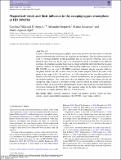Files in this item
Magnetized winds and their influence in the escaping upper atmosphere of HD 209458b
Item metadata
| dc.contributor.author | Villarreal D'Angelo, Carolina | |
| dc.contributor.author | Esquivel, Alejandro | |
| dc.contributor.author | Schneiter, Matías | |
| dc.contributor.author | Sgró, Mario Agustín | |
| dc.date.accessioned | 2018-08-31T16:30:07Z | |
| dc.date.available | 2018-08-31T16:30:07Z | |
| dc.date.issued | 2018-09-21 | |
| dc.identifier | 255653384 | |
| dc.identifier | 60abe67f-cbbf-409b-8924-d1d29a25f06c | |
| dc.identifier | 85051517429 | |
| dc.identifier | 000441382300017 | |
| dc.identifier.citation | Villarreal D'Angelo , C , Esquivel , A , Schneiter , M & Sgró , M A 2018 , ' Magnetized winds and their influence in the escaping upper atmosphere of HD 209458b ' , Monthly Notices of the Royal Astronomical Society , vol. 479 , no. 3 , pp. 3115-3125 . https://doi.org/10.1093/mnras/sty1544 | en |
| dc.identifier.issn | 0035-8711 | |
| dc.identifier.uri | https://hdl.handle.net/10023/15931 | |
| dc.description | CVD acknowledges STFC (ST/M001296/1) and the PhD fellowship from CONICET. MAS acknowledges support from the CONICET via an Assistant Research Fellowship. The authors want to thank the Centro de Simulación Computacional para Aplicaciones Tecnológicas - CONICET, where some of the test of the code was run. AE acknowledges support from CONACYT DGAPA-PAPIIT (UNAM) grants IN 109715 and IG 100516. | en |
| dc.description.abstract | Lyman a observations during an exoplanet transit have proved to be very useful to study the interaction between the stellar wind and the planetary atmosphere. They have been extensively used to constrain planetary system parameters that are not directly observed, such as the planetary mass-loss rate. In this way, Ly α observations can be a powerful tool to infer the existence of a planetarymagnetic field, since it is expected that the latterwill affect the escaping planetary material. To explore the effect that magnetic fields have on the Ly α absorption of HD 209458b, we run a set of 3D MHD simulations including dipolar magnetic fields for the planet and the star. We assume values for the surface magnetic field at the poles of the planet in the range of [0-5] G, and from 1 to 5 G at the poles of the star. Our models also include collisional and photo-ionization, radiative recombination, and an approximation for the radiation pressure. Our results show that the magnetic field of the planet and the star change the shape of the Ly α absorption profile, since it controls the extent of the planetary magnetosphere and the amount of neutralmaterial inside it. Themodel that best reproduces the absorption observed in HD 209458b (with canonical values for the stellar wind parameters) corresponds to a dipole planetary field of ≲ 1 G at the poles. | |
| dc.format.extent | 11 | |
| dc.format.extent | 2379055 | |
| dc.language.iso | eng | |
| dc.relation.ispartof | Monthly Notices of the Royal Astronomical Society | en |
| dc.subject | MHD-methods: numerical | en |
| dc.subject | Planet-star interactions | en |
| dc.subject | Planets and satellites: general | en |
| dc.subject | Planets and satellites: individual: HD 209458b | en |
| dc.subject | Stars: winds, outflows | en |
| dc.subject | QB Astronomy | en |
| dc.subject | QC Physics | en |
| dc.subject | Astronomy and Astrophysics | en |
| dc.subject | Space and Planetary Science | en |
| dc.subject | DAS | en |
| dc.subject.lcc | QB | en |
| dc.subject.lcc | QC | en |
| dc.title | Magnetized winds and their influence in the escaping upper atmosphere of HD 209458b | en |
| dc.type | Journal article | en |
| dc.contributor.sponsor | Science & Technology Facilities Council | en |
| dc.contributor.institution | University of St Andrews. School of Physics and Astronomy | en |
| dc.identifier.doi | https://doi.org/10.1093/mnras/sty1544 | |
| dc.description.status | Peer reviewed | en |
| dc.identifier.grantnumber | ST/M001296/1 | en |
This item appears in the following Collection(s)
Items in the St Andrews Research Repository are protected by copyright, with all rights reserved, unless otherwise indicated.

